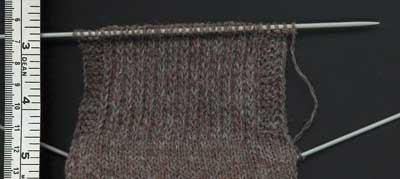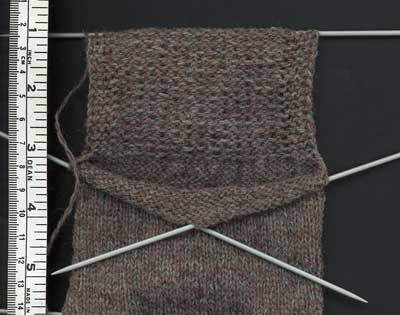I suppose I should clarify something from yesterday. I rearranged the stitches on the needles in a way that involved moving the fewest stitches, which is OK because the tops of the socks are the same all around. If you are knitting a stocking or knee sock with a shaped calf or have put a pattern in the top of the sock, of course you would shift the stitches so that the center of the heel flap continues the center line of the back.
After knitting the socks to the "points" of the ankle bones, I am now working back and forth on half the stitches (36) to form the heel flap. Now I need to deal with a vertical edge or selvage.
I slip the first stitch, knit three stitches (to form a garter stitch border), then knit one slip one across the row (knit the odd stitches, slip the even ones), then knit the last four stitches, turn, and slip the first stitch, knit the next three stitches, then purl for 28 stitches, finally knit the last four stitches then turn and repeat these two rows. The first few rows feel bit awkward, but are easier to handle as the flap gets longer.
Tip: To make a neat edge, either slip the first stitch on each row or the first and last stitch on every other row. Orientation is important. If the stitch looks like a knit stitch, insert the needle as if to knit and slide it over. If the last stitch looks like a purl (which is what I have with the garter border), insert the needle as if to purl, slip the stitch to the new needle, then throw the yarn over and continue knitting.


Unless they are worn with clogs or sandals (or other backless shoes) this is the part of the sock that protects the part of the foot that can be most subject to developing blisters. The back of the heel doesn't bear the full weight of the body but in vigorous walking, especially on steep slopes and uneven ground, the heel tries to move up and down in the heel cup of the boot. Wearing a hiking boot with a snug top (and a scree collar) can minimize this but it can be a real problem in low shoes and boots with loose tops. The extra material with the pattern adds some extra thickness and stiffness.
The edges of the heel flap will lie in the hollow formed by the ankle bones for most people, so there should be no problems for the garter ridges and the sort of seam where the stitches are picked up to form the gusset.
This is probably best answered by looking at the shape of the foot which will wear the sock, a further advantage of making hand knit socks. Patterns for adult socks call for from two to three inches. I particularly like Elizabeth Zimmerman's elegant solution in Knitting Without Tears of making as many rows in the heel flap as there are stitches across. This is 36 rows which is easy to count as 18 of the garter stitch ridges on the borders. She calls this a square, but it actually becomes a rectangle.
I will finish the flaps to get ready to turn the heel tomorrow .